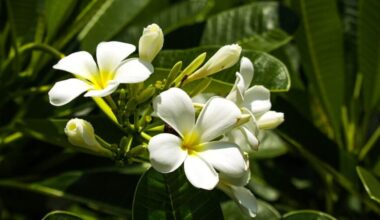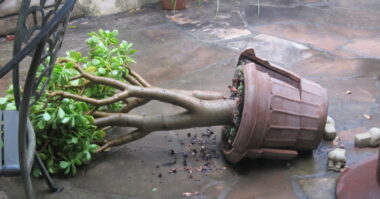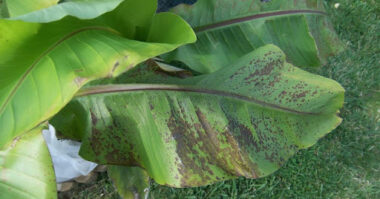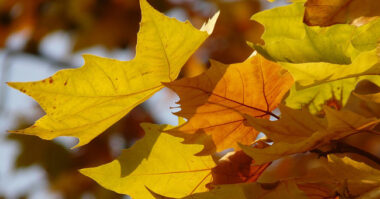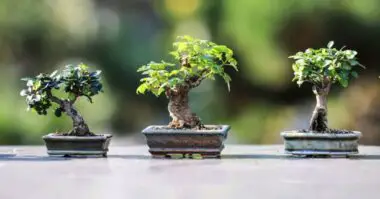Blackleaf pear disease is affecting your fruit tree. Your beautiful pear tree, which you pamper with so much attention, shows black, stained leaves. But what is this disease? There are in fact several possibilities between fire blight, scab, entomosporiosis or even fumaginia.
It is important to act as soon as possible, because cryptogamic diseases are no joke and can also be very contagious and spread in your garden or orchard. However, the best thing to do is to prevent and treat your fruit trees before they develop any of these very unfortunate diseases.
Contents
Entomosporiosis: Black spots on the leaves
This fungal disease, caused by the fungus Entomosporium maculatum, shows its first signs on the youngest leaves: small circular spots, varying between brown and red, and crusts. These spots spread and coalesce, covering a large part of the leaf.
Older leaves show the same type of spots, but they are brown with a gray center and a dark reddish brown outline. In the center of the spots, black dots can be seen, which are spore-producing areas, particularly characteristic of this disease. The petioles are affected, then the young shoots. Fruits are also affected, marked with black and crusty spots, becoming hard to the touch.
Frequently, they become mummified on the tree. The whole foliage eventually falls off and the fruits are too affected to be eaten. The lack of leaves weakens the tree. The tree will not die, but its growth may be slowed down.
The black leaves that fall to the ground are responsible for the first contamination in spring, as the spores are easily dispersed. Afterwards, it is the spore-bearing areas on the tree that spread the infection, especially during mild and humid periods. Only in summer, when it is dry and hot, there is no spore production.
Severity scale
Crop loss
Potentially important by the reduction of tree vigor
Solutions
The fight against this disease of black pear is difficult when it is well established, it is strongly advised to act at the first signs by removing all the affected leaves, fruits and branches. These will of course be burned.
- As a preventive measure, remove all dead leaves from the base of your pear trees.
- When planting, space your fruit trees.
- Aerate the center of your trees during maintenance pruning and remove dead branches which are real pathogen nests.
- Some varieties are less sensitive than others, get information before buying.
- Use Bordeaux mixture: one application after leaf fall and then at bud break in the spring. It will then be renewed once a month until the fruits appear.
How to protect pear trees against diseases?
Blister, scab, chancre, powdery mildew, fire blight, rot and rust are the main diseases of pear trees.
In prevention
Choose a rootstock adapted to the soil and climate.
Drain the soil at planting, stagnant humidity is harmful.
Water and fertilize regularly and wisely to avoid deficiencies that can weaken the tree.
- Always use disinfected tools when pruning and putty the wounds.
- Clean the soil well.
- Remove mummified fruits on the tree.
- Cut and burn the parts affected by diseases.
Products to apply in prevention
- Spray Bordeaux mixture at the end of winter and at bud break.
- Spray sulphur before flowering.
- Spray a decoction of horsetail every month during the growing season.
How to protect pear trees against parasites ?
Phytoptes, mites, codling moth, psyllids, aphids and mealy bugs are the main pests of pear trees.
Prevention
Brush the trunks in winter to dislodge the larvae present under the bark.
Clean the soil well.
Install pheromone traps in the tree and a strip of glue around the trunk.
Spray nettle or horsetail manure on the foliage very often.
At the end of winter, spray white oil on all aerial parts to kill scale insects.
Protecting pear trees from the elements
Do not plant pear trees above 1000 meters altitude, because although the tree is hardy to -4°F, the flowers are destroyed as soon as 28°F.
In colder areas trellis the pear tree against a well exposed wall.
The pear tree does not tolerate calcareous soils: choose a suitable rootstock or dig a pit that you will fill with heather soil.
The pear tree does not tolerate drought: do not neglect watering.
Protect the pear tree against birds
Bag the fruit.
Hang shiny and moving scarecrows in the branches (CDs, ribbons, aluminum foil…).
Protect pear trees against slugs
Slugs only attack fruit that has fallen to the ground. Collect and consume quickly the ripe fruits that have fallen on the ground.
Summary
Good growing conditions and care, a high level of biodiversity, resistant varieties and rootstocks adapted to the soil, these are proven methods to reinforce the resistance of your fruit trees, and of all plants for that matter.
Being vigilant is also an effective act of prevention, so that you can act as soon as possible. Blackleaf pear diseases are indeed very contagious and difficult to eradicate once they have set in. As always, prevention is better than cure!

